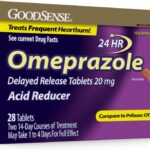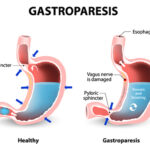How To Stop Taking Omeprazole Safely

Medication compliance or adherence refers to the degree or extent of conformity to the recommendations about day-to-day treatment by the provider with respect to the timing, dosage, and frequency. It may be defined as the extent to which a patient acts in accordance with the prescribed interval, and dose of a dosing regimen.
Adherence to therapies is a primary determinant of treatment success. Failure to adhere to the prescribed regimen is a serious problem that not only affects the patient but also the health care system. Medication non-adherence in patients leads to substantial worsening of disease, death, and increased health care costs.
What is Omeprazole?
Omeprazole, a medication sold under the brand names Prilosec and Losec, among others, is used in the treatment of gastroesophageal reflux disease, peptic ulcer disease, and Zollinger–Ellison syndrome. Prescription omeprazole is used alone or with other medications to treat the symptoms of gastroesophageal reflux disease (GERD), a condition in which backward flow of acid from the stomach causes heartburn and possible injury of the esophagus (the tube between the throat and stomach) in adults and children 1 year of age and older.
Prescription omeprazole is used to treat damage from GERD in adults and children 1 month of age and older. Prescription omeprazole is used to allow the esophagus to heal and prevent further damage to the esophagus in adults and children 1 year of age and older with GERD. Prescription omeprazole is also used to treat conditions in which the stomach produces too much acid such as Zollinger-Ellison syndrome in adults. Prescription omeprazole is also used to treat ulcers (sores in the lining of the stomach or intestine) and it is also used with other medications to treat and prevent the return of ulcers caused by a certain type of bacteria (H. pylori) in adults.
Nonprescription (over-the-counter) omeprazole is used to treat frequent heartburn (heartburn that occurs at least 2 or more days a week) in adults. Omeprazole is in a class of medications called proton-pump inhibitors. It works by decreasing the amount of acid made in the stomach.

How should I take omeprazole?
Prescription omeprazole comes as a delayed-release (releases the medication in the intestine to prevent break-down of the medication by stomach acids) capsule and packets of delayed-release (releases the medication in the intestine to prevent break-down of the medication by stomach acids) granules for suspension (to be mixed with liquid) to take by mouth or give through a feeding tube. Nonprescription (over-the-counter) omeprazole comes as a delayed-release tablet to take by mouth. Prescription omeprazole should be taken at least 1 hour before a meal. Prescription omeprazole is usually taken once a day before a meal but may be taken twice a day when used with other medications to eliminate H. pylori, or up to three times a day, before meals when used to treat conditions in which the stomach produces too much acid. The nonprescription delayed-release tablets are usually taken once a day in the morning at least 1 hour before eating for 14 days in a row. If needed, additional 14-day treatments may be repeated, not more often than once every 4 months. To help you remember to take omeprazole, take it at around the same time(s) every day. Follow the directions on your prescription label or the package label carefully, and ask your doctor or pharmacist to explain any part you do not understand. Take omeprazole exactly as directed. Do not take more or less of it or take it more often or for a longer period of time than prescribed by your doctor or stated on the package.
If you are taking the delayed-release tablets, swallow them whole with a full glass of water. Do not split, chew, or crush them or crush and mix them into food.
Swallow the delayed-release capsules whole. If you have difficulty swallowing the delayed-release capsules, place one tablespoon of soft, cool applesauce in an empty bowl. Open the delayed-release capsule and carefully empty all the granules inside the capsule onto the applesauce. Mix the granules with the applesauce and swallow the mixture immediately with a glass of cool water. Do not chew or crush the granules. Do not store the applesauce/granule mixture for future use.
If you are taking the granules for oral suspension, you will need to mix it with water before use. If you are using the 2.5-mg packet, place 1 teaspoonful (5 mL) of water in a container. If you are using the 10-mg packet, place 1 tablespoonful (15 mL) of water in a container. Add the contents of the powder packet and stir. Wait for 2 to 3 minutes to allow the mixture to thicken, and stir the mixture again. Drink the entire mixture within 30 minutes. If any of the mixtures is stuck to the container, pour more water into the container, stir and drink all the mixture immediately.
The granules for oral suspension can be given through a feeding tube. If you have a feeding tube, ask your doctor how you should take the medication. Follow the directions carefully.
Do not take nonprescription omeprazole for immediate relief of heartburn symptoms. It may take 1 to 4 days for you to feel the full benefit of the medication. Call your doctor if your symptoms get worse or do not improve after 14 days or if your symptoms return sooner than 4 months after you finish your treatment. Do not take nonprescription omeprazole for longer than 14 days or treat yourself with omeprazole more often than once every 4 months without talking to your doctor.
Continue to take prescription omeprazole even if you feel well. Do not stop taking prescription omeprazole without talking to your doctor. If your condition does not improve or gets worse, call your doctor. Ask your pharmacist or doctor for a copy of the manufacturer’s information for the patient.
How to Stop Taking Omeprazole Safely
Stopping omeprazole can result in rebound acid secretion, where the acid secretion in your stomach increases significantly. You should discuss with your doctor before stopping omeprazole, when handled properly, even the excess acid secretion in your stomach can return to normal within 2 weeks this explains why experts recommend slowly weaning yourself off your omeprazole with the help of a reflux doctor.
Generally, most doctors will recommend a taper down the dose. For example, if someone is on 20 mg of omeprazole twice daily, they will reduce the dose to 20 mg a day for 10 days and then 20 mg every other day for 10 days before stopping.
What are the side effects of omeprazole?
According to Medical News Today, omeprazole doesn’t cause drowsiness. However, it can cause other side effects.
More common side effects
The side effects of this drug are slightly different for children and adults.
• Adult side effects can include:
o headache
o stomach pain
o nausea
o diarrhea
o vomiting
o gas
• Children’s side effects can include the above, plus the following:
o fever
If these effects are mild, they may go away within a few days or a couple of weeks. If they’re more severe or don’t go away, talk to your doctor or pharmacist.
Serious side effects
Call your doctor right away if you have serious side effects. Call 911 if your symptoms feel life-threatening or if you think you’re having a medical emergency. Serious side effects and their symptoms can include the following:
• Low magnesium levels. Using this drug for 3 months or longer can cause low magnesium levels. Symptoms can include:
o seizures
o irregular or fast heart rate
o tremors
o jitteriness
o muscle weakness
o dizziness
o spasms of your hands and feet
o cramps or muscle aches
o spasm of your voice box
• Vitamin B-12 deficiency. Using this drug for longer than three years can make it harder for your body to absorb vitamin B-12. Symptoms can include:
o nervousness
o neuritis (inflammation of a nerve)
o numbness or tingling in your hands and feet
o poor muscular coordination
• Severe diarrhea. This may be caused by a Clostridium difficile infection in your intestines. Symptoms can include:
o watery stool
o stomach pain
o fever that doesn’t go away
• Inflammation of your stomach lining. Symptoms can include:
o stomach pain
o nausea
o vomiting
o weight loss
• Bone fractures
• Kidney damage. Symptoms can include:
o flank pain (pain in your side and back)
o changes in urination
• Cutaneous lupus erythematosus (CLE). Symptoms can include:
o rash that may involve the skin of the nose
o raised, red, scaly, red, or purple rash on your body
• Systemic lupus erythematosus (SLE). Symptoms can include:
o fever
o tiredness
o weight loss
o blood clots
o heartburn
• Fundic gland polyps (growths on the lining of your stomach that don’t usually cause symptoms)
You can also find useful information on Is Tinnitus From Omeprazole Permanent





